US National Aeronautics and Space Administration (NASA)'s senior Mars rover Opportunity has survived the worst part of its eighth Martian winter with its solar panels in encouragingly clean condition for entering a potential dust-storm season in 2018.

The long Martian year lasts 687 Earth days. The winter weeks with the shortest days are in October and November.
NASA's twin rovers Spirit and Opportunity landed on Mars in January 2004. Their mission – searching for signs of past water activity on the Red Planet – was scheduled to last 90 Martian days, roughly about three Earth months.
"Now, Opportunity has made it through the worst part of its eighth Martian winter," Jennifer Herman, power subsystem operations team lead for Opportunity at NASA's jet propulsion laboratory in Pasadena, California, said in a news release.
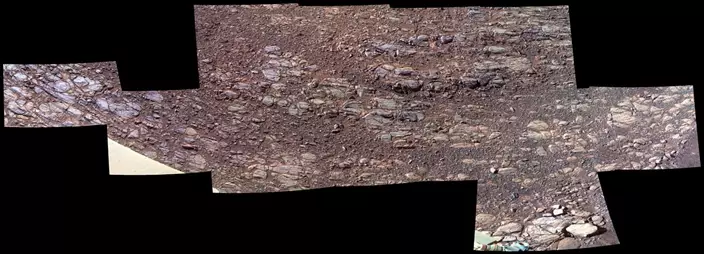
A small section of Perseverance Valley captured by Opportunity in October 2017 /NASA Photo
Both Opportunity and Spirit are in Mars' southern hemisphere, where the Sun appears in the northern sky during fall and winter. Spirit lost the use of two of its wheels in 2009.
Opportunity is currently exploring "Perseverance Valley", a valley-like area possibly carved out by fluids on the inner slope of a vast crater named Endeavor Crater.
Since reaching the upper end of the valley five months ago, the rover has used "lily pads" – energy-favorable locations on the planet – to stock up on solar energy.
"Relying on solar energy for Opportunity keeps us constantly aware of the season on Mars and the terrain that the rover is on," Herman said.
The situation has not always been sunny.
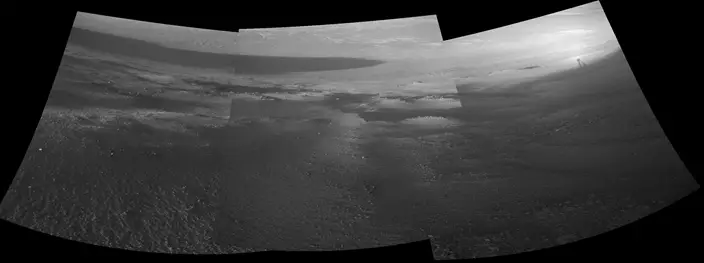
NASA's Mars rover Opportunity captured this view of late-afternoon shadows, including one cast by the rover itself, stretching toward the floor of Endeavour Crater. /NASA Photo
In its fifth winter in 2011-2012, Opportunity was forced to spend 19 weeks at a single spot because no other suitable sunny spots were within acceptable driving distance. It was in sharp contrast to its first busy winter in the southern half of a stadium-sized crater, where all of the ground faced north and got plenty of sunshine.
Yet another factor that can interfere with the rover's ability to charge is the amount of dust accumulating on its solar array and in the sky.
Winds can clean some of the dust. But they can also stir up dust storms that block sunlight and then drop dust onto the rover.
"We were worried that the dust accumulation this winter would be similar to some of the worst winters we've had and that we might come out of the winter with a very dusty array, but we've had some recent dust cleaning that was nice to see," Herman said.
"Now I'm more optimistic. If Opportunity's solar arrays keep getting cleaned as they have recently, she'll be in a good position to survive a major dust storm. It's been more than 10 Earth years since the last one and we need to be vigilant."
The storm in 2007 sharply reduced available sunlight for the twins, forcing scientists to limit the rovers' scientific activities.
In the coming months, the team plans to continue exploring Perseverance, searching for clues about how the valley was carved inside the crater rim.
UNITED NATIONS (AP) — Russia and Ukraine on Monday traded blame before the United Nations Security Council for the attacks on Europe’s largest nuclear power plant, which the head of the International Atomic Energy Agency said have put the world “dangerously close to a nuclear accident.”
Without attributing blame, IAEA Director General Rafael Mariano Grossi said his agency has been able to confirm three attacks against the Zaporizhzhia Nuclear Power Plant since April 7.
“These reckless attacks must cease immediately,” he told the Security Council. “Though, fortunately, they have not led to a radiological incident this time, they significantly increase the risk … where nuclear safety is already compromised.”
The remote-controlled nature of the drones that have attacked the plant means that it is impossible to definitively determine who launched them, Grossi told reporters after the meeting.
“In order to say something like that, we must have proof,” he said. “These attacks have been performed with a multitude of drones.”
Zaporizhzhia sits in Russian-controlled territory in southeastern Ukraine and has six nuclear reactors.
Fears of a nuclear catastrophe have been at the forefront since Russian troops occupied the plant shortly after invading in February 2022. Continued fighting between Russian and Ukrainian forces — as well as the tense supply situation at the plant — have raised the specter of a disaster.
Ukraine and its allies on Monday again blamed Russia for dangers at the site, with the United States saying, “Russia does not care about these risks.”
“If it did, it would not continue to forcibly control the plant,” U.S. deputy ambassador Robert Wood told the Security Council, which met at the initiative of the U.S. and Slovenia.
Russia, for its part, said Ukraine was to blame for the attacks.
“The IAEA’s report does not pinpoint which side is behind the attacks,” Russia’s U.N. Ambassador Vassily Nebenzia said. “We know full well who it is.”
“Over the last few months, such attacks not only resumed,” Nebenzia said, “they significantly intensified.”
Ukraine’s ambassador to the U.N., Sergiy Kyslytsya, called the attacks “a well-planned false flag operation by the Russian Federation,” which he alleged Russia had designed to distract the world from its invasion of its neighbor.
The Zaporizhzhia facility is one of the 10 biggest nuclear plants in the world. Fighting in the southern part of Ukraine where it is located has raised the specter of a potential nuclear disaster like the one at Chernobyl in 1986, where a reactor exploded and blew deadly radiation across a vast area.
Neither Russia nor Ukraine in recent months has been able to make significant advances along the 1,000-kilometer (620-mile) front line crossing eastern and southern Ukraine. Drones, artillery and missiles have featured heavily in what has become a war of attrition.
Russia and Ukraine have frequently traded accusations over the Zaporizhzhia plant.
The most recent strikes did not compromise the facility, which is designed to withstand a commercial airliner crashing into it, the IAEA said.
The plant’s six reactors have been shut down for months, but it still needs power and qualified staff to operate crucial cooling systems and other safety features.
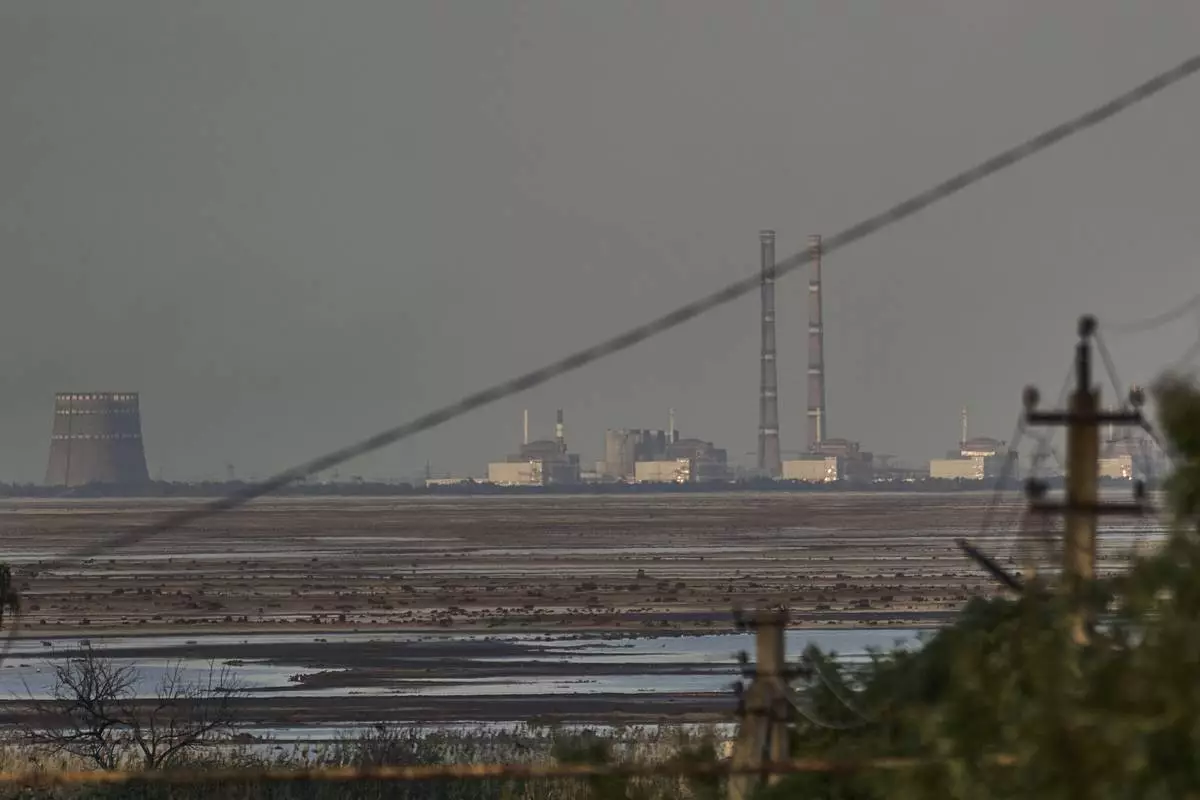
FILE - The Zaporizhzhia nuclear power plant, Europe's largest, is seen in the background of the shallow Kakhovka Reservoir after the dam collapse, in Energodar, Russian-occupied Ukraine, Tuesday, June 27, 2023. Officials at the Russian-controlled Zaporizhzhia Nuclear Power Plant said that the site was attacked Sunday April 7, 2024, by Ukrainian military drones, including a strike on the dome of the plant’s sixth power unit. (AP Photo/Libkos, File)
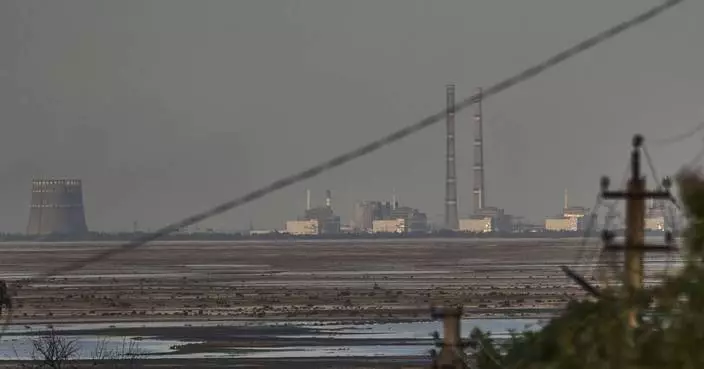
IAEA warns that attacks on a nuclear plant in Russian-controlled Ukraine put the world at risk
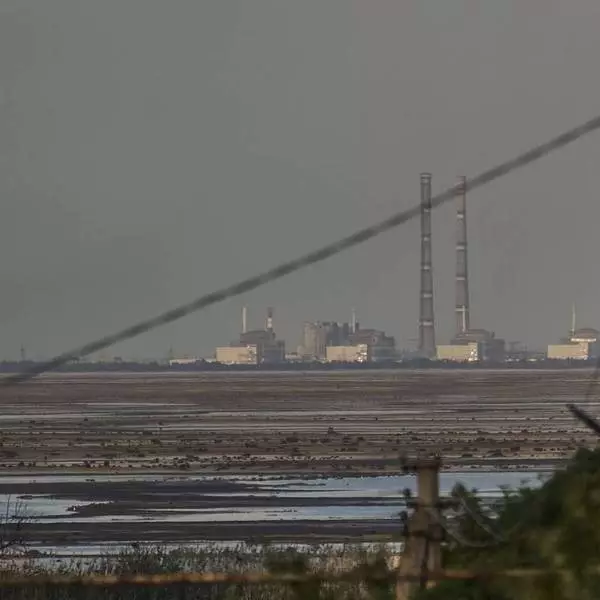
IAEA warns that attacks on a nuclear plant in Russian-controlled Ukraine put the world at risk









